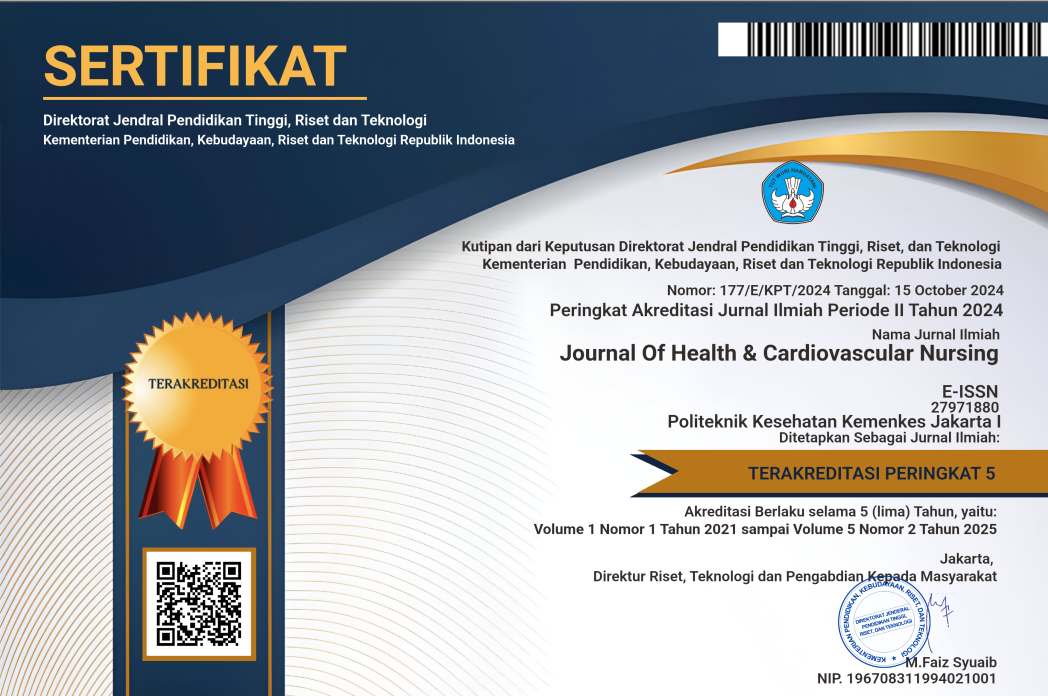Administration of Spinach and Tomato Juice to Overcome Nutrition Deficit in third Trimester Pregnant Women with Anemia: Case Study
Pemberian Jus Bayam Dan Tomat Untuk Mengatasi Defisit Nutrisi Pada Ibu Hamil Trimester Tiga Dengan Anemia: Studi Kasus
Keywords:
Anemia, Defisit nutrisi, Ibu hamil, Jus bayam dan tomatAbstract
Pregnant is the part of reproduction process as Human. Nursing Care Plan by Giving Spinach and Tomato Juice toDecrease Nutrition Deficit for 3rd Trimester Pregnant Woman with Anemia. Pregnancy is one part of the process ofhuman reproduction. Nutrition is one of the factors that influence pregnancy. Nutritional needs during pregnancyincrease, one of them is iron which plays a role in the formation of red blood cells. Physiologically, in pregnant womenan increase in blood volume in large numbers. If not balanced with the consumption of sufficient substances can causeanemia. The purpose of this paper is to provide an analysis of the implementation of nursing care nutritional deficitproblems for pregnant women with anemia. Anemia is a state of blood hemoglobin (Hb) levels lower than normal levelsaccording to age and sex. This articles using case study methods, and using instrument measuremement Hb levels beforeand after the intervention. One nursing intervention to overcome anemia is by giving spinach juice and tomatoes thatcontain iron. Spinach juice and tomatoes are gave to pregnant woman for 10 days. The results obtained indicate that theclient experienced an increase in hemoglobin level of 10.1 g / dl from 8,7 gr/dL. This study prove by giving spinach andtomato juice for 10 days increasing Hb levels in third trimester pregnant woman.Downloads
References
Abdelhafez, A. M., & El-Soadaa, S. S. (2012). Prevalence and Risk Factors of Anemia among a Sample of Pregnant Females Attending Primary Health Care Centers in Makkah, Saudi Arabia. Pakistan Journal of Nutrition, 11(12), 1113–1120.
Bender, D. A. (2013). Physiology, Dietary Sources, and Requirements. In Encyclopedia of Human Nutrition (pp. 363–369). https://doi.org/10.1016/B978-0-12-375083-9.00019-2
DeLoughery, T. G. (2017). Iron Deficiency Anemia. Medical Clinical North America, 101, 319–332. https://doi.org/10.1016/j.mcna.2016.09.004
Engstrom, J. L., & Sittler, C. P. (2010). Nurse-midwifery management of iron-deficiency anemia during pregnancy. Journal of Nurse Midwifery, 39(2), 208–345.
Fredriksen, J., Løken, E. B., Borgejordet, Å., Gjerdevik, K., & Nordbotten, A. (2009). Unexpected sources of vitamin C. Food Chemistry, 113, 832–834. https://doi.org/10.1016/j.foodchem.2008.05.019
Kementerian Kesehatan RI. (2018). Hasil utama Riskesdas 2018. Jakarta: Kementerian Kesehatan RI.
Kementerian Kesehatan RI. (2020). Data dan informasi: profik kesehatan Indonesia 2019. Jakarta: Kementerian Kesehatan RI.
Lowdermilk, D. L., Perry, S. E., & Cashion, K. (2014). Maternity nursing. Maryland Heights, MO: Elsevier Mosby.
Lucas, C., Charlton, K. E., & Yeatman, H. (2014). Nutrition advice during pregnancy: do women receive it and can health professionals provide it? University of Wollongong.
Meylawati, L. E., Nursanti, I., & Widakdo, G. (2019). Efektivitas pemberian jus bayam, jus tomat, dan kombinasi terhadap kadar hemoglobin ibu hamil dengan anemia di RSAU dr. Esnawan Antariksa Jakarta tahun 2018. Jurnal Keperawatan Dan Kesehatan Medisna, 5(9), 1–12.
Noronha, J. A., Khasawneh, E. A., Seshan, V., Ramasubrahmaniam, S., & Raman, S. (2012). Anemia in pregnancy- Consequence and challenges: A review of literature. Journal of South Asian Federation of Obstetrics and Gynaecology, 4(1), 64–70. https://doi.org/10.5005/jp-journals-10006-1177
Reeder, S. J., Martin, L. L., & Griffin, D. K. (2011). Keperawatan maternitas: kesehatan wanita, bayi, & keluarga. (Y. Afiyanti, I. N. Rachmawati, & S. Djuwitaningsih, Eds.) (18th ed.). Jakarta: EGC.
Ricci, S. S., & Kyle, T. (2009). Maternity and pediatric nursing. Philadelphia: Lippincott Williams & Wilkins.
Rohmatika, D., & Umarianti, T. (2017). Efektifitas pemberian ekstrak bayam terhadap peningkatan kadar hemoglobin pada ibu hamil dengan anemia ringan. Jurnal Kebidanan, 9(2), 165–174.
Sanchez, A. S., Castillo, J. A. A., Pena, R. I. P., & Penafiel, C. O. R. (2015). Dietary recommendations in patients with deficiency anaemia. Revista Medica Del Hospital General de Mexico, 78(3), 144–150. https://doi.org/http://dx.doi.org/10.1016/j.hgmx.2015.06.002
Skinner, J. A., & Kowalski, R. M. (2013). Profiles of sibling bullying. Journal of Interpersonal Violence, 28, 1726–1736. https://doi.org/10.1177/0886260512468327
Tomas, M., & Jafari, S. M. (2018). Influence of Food Processing Operations on Vitamins. Encyclopedia of Pharmacy Practice and Clinical Pharmacy, 1–12.
Wall, C., & Gillies, N. (2019). Nutritional Anemias. Encyclopedia of Pharmacy Practice and Clinical Pharmacy, 776–792. https://doi.org/http://dx.doi.org/10.1016/B978-0-12-812735-3.00564-1
Ward, S. L., & Hisley, S. M. (2009). Maternal-child nursing care: optimizing outcomes for mothers, children, and families. Philadelphia: F.A. Davis Company.
White, L., Duncan, G., & Baumle, W. (2011). Foundations of maternal & pediatric nursing. Australia: Delmar Cengage Learning.
Wigati, P. W., & Firdaus, N. (2018). Pengaruh Pemberian Kombinasi Jus Bayam dan Jambu Biji terhadap Kadar Hemoglobin pada Ibu Hamil di Wilayah Kerja Puskesmas Balowerti Kota Kediri. Journal for Quality in Women’s Health, 1(2), 7–10. https://doi.org/10.30994/jqwh.v1i2.10
Published
Issue
Section
Copyright (c) 2023 Journal of Health and Cardiovascular Nursing

This work is licensed under a Creative Commons Attribution-ShareAlike 4.0 International License.









